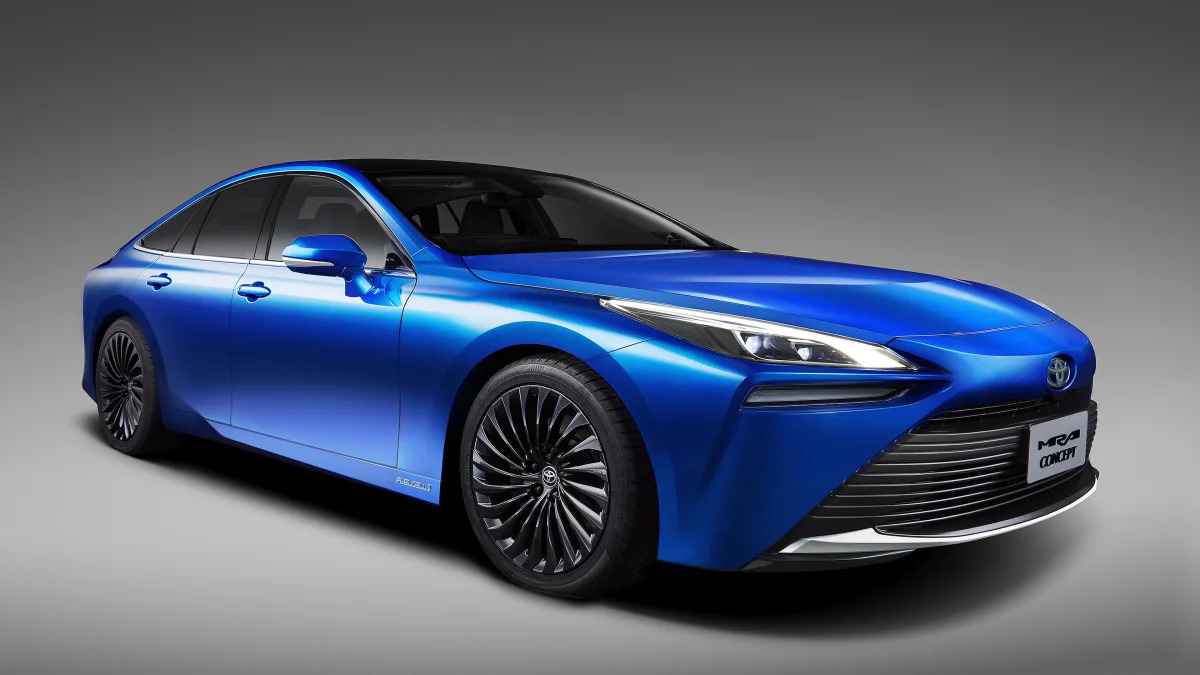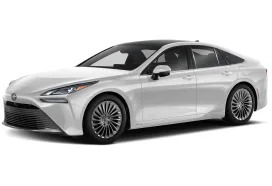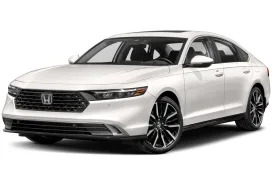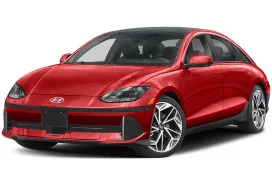Although the current Toyota Mirai is only sold in California, the company chose Greensboro, North Carolina to unveil the second generation of the hydrogen-fuel-cell-powered sedan. Greensboro. Get it? The 2021 Toyota Mirai was also unveiled around the eighth of October. Why? Because that’s National Hydrogen and Fuel Cell Day. Why? Because 10/8 is close to 1.008, which is the atomic weight of hydrogen.
Toyota essentially owns the hybrid market in North America. It invented the segment back in 2000 with the original Prius, and last year 44% of all hybrids sold in the United States were Toyotas. Today, the brand sells about 10 million vehicles a year globally, offers six hybrids (not counting the Lexus models), and says there are more to come. By 2025, the plan is to offer an electrified option on every vehicle in its global lineup, which it hopes will take its U.S.-market hybrid sales from 9% in 2018 to 25% in 2025.
Americans also buy the bulk of Mirais. Since 2015, Toyota has sold about 9,000 around the world, 6,000 of which were bought or leased by Californians from the state’s eight authorized Mirai dealers — four in Northern California and four in SoCal.
To increase the sedan’s appeal, Toyota has targeted a 30% increase in driving range, increased rear-seat legroom, added a fifth seat and, most importantly, completely redesigned its exterior. While the current Mirai ranks high on the Ugliest Cars of All Time list, the 2021 Mirai is a genuine looker on a par with the Tesla Model S.
The car is striking in the flesh, with broad shoulders, a fastback roofline and a long snout. There’s some Lexus LFA in its proportions, with slab sides and a blunt tail with taillights that stretch across accentuating its width. The new Mirai isn’t a hatchback like the Model S, instead it has a conventional trunk. It looks like conventional premium luxury sedan, and if you told us it was the next Lexus GS we wouldn’t flinch. Its designers even included a large low grille, which is Avalon-like, and two openings under its rear bumper that imply tailpipes.
Other interesting details are its black roof, A-pillars visually slimmed by strips of black trim and intricate 20-inch wheels wrapped in 245/45R20 Bridgestone all-season rubber. Elegantly, there aren’t any superfluous scoops and flares. Its headlights reach back to the tops of its front tires. When this thing hits the street, the Honda Clarity will officially become America’s ugliest fuel-cell vehicle.
The Mirai is also considerably larger than before. At 195.8 inches in length it’s 3.3 inches longer and its 114.9-inch wheelbase has grown by 5.5 inches. Its width has climbed from 71.5 inches to 74.2 inches, and with a height of just 57.8 inches it’s nearly three inches lower than its frumpy predecessor. The Mirai also will seat five for the first time, but it’s still not as large as the Lexus LS, which is still more than 10 inches longer and has an 8-inch-longer wheelbase. Like the current Mirai, the new version will be assembled in Japan.
In the current market you have to wonder why the 2021 Mirai isn’t an SUV or a crossover instead of a sedan. “It’s a global car so we had to consider the global market,” says Tom Kretschmann, a Toyota spokesman. “SUVs are high demand in the U.S. but not so much in the rest of the world including Europe, Japan and China.”
The Mirai looks like it’s rear-wheel drive because it is, sharing its platform with the Lexus LS sedan and LC coupe. The switch from front-wheel drive has forced a repackaging of its drivetrain components, but Jackie Birdsall, senior engineer in Toyota’s Fuel Cell Hybrid Vehicle group, declined to elaborate on those changes.
The current Mirai’s “fuel stack,” which includes the fuel cell and the motor generator, is located up front under the hood. Today’s model uses the same nickel-metal-hydride batteries as the Camry Hybrid, and they’re mounted behind the rear seat. Toyota will not confirm whether the new Mirai will switch to lithium-ion batteries, which are now used in all front-wheel-drive Prius models, and which also will power the company’s future EV model. (The all-wheel-drive Prius still uses nickel-metal-hydride batteries, because they work more efficiently in cold weather.)
Birsall does say the 2021 Mirai’s increase in range will come from a combination of increased efficiency and additional hydrogen storage. The current car’s two carbon-fiber-reinforced tanks are mounted under the rear seat and have a total capacity of 5 kilograms. The 2019 Mirai has an EPA-estimated driving range of 312 miles.
Toyota also says the new Mirai will be more powerful and quieter than today’s car. The current model’s electric motor generates 113 kW or the equivalent of 151 horsepower, and it does 0-60 mph in 9 seconds.
The new Mirai’s cabin follows current Toyota protocol with swoopy dash lines and a large console. There’s digital instrumentation and the same dash-mounted shifter used in the current Mirai and Prius models. There’s also a 12.3-inch touchscreen, a 14-speaker stereo, heated and cooled front seats and a wireless phone-charging pad that takes up much of the console. The prototype we examined in person did not have an interior, but the photos also reveal a drive mode button behind the shifter and white stitching throughout its black leather interior.
“We have pursued making a car that customers feel like driving all the time, a car that has emotional and attractive design appeal, as well as dynamic and responsive driving performance that can bring a smile to the faces of drivers,” says Yoshikazu Tanaka, the Mirai’s chief engineer. “I want customers to say, ‘I chose the Mirai not because it’s an FCEV, but because I really wanted this car, and it just happened to be an FCEV.’”
When it goes on sale late next year, the 2021 Mirai will probably still be limited to the California market, but Toyota is working to expand that footprint, fighting for infrastructure expansion and grappling with municipal bureaucracies in the Northeast and Pacific Northwest. “We’re close to opening up the Northeast market,” says Kretschmann. “The infrastructure is there, but there are still some regulations we’re dealing with. Transporting hydrogen through Massachusetts, for instance, is still a problem, but we’re working on it.”
Toyota says it spends $1 million an hour on R&D, and it’s the world’s largest manufacturer of fuel-cell stacks in world, currently making 3,000 a year. It hopes market expansion, infrastructure growth and the greater appeal of the new Mirai’s design will drive sales, with aspirations to move 30,000 a year in the United States. But the price is also going to climb.
“We are going to market it as a premium sedan,” says Kretschmann. Today the Mirai has an MSRP of $58,500, but more than 95% are leased, with payments of between $300 and $400 per month. The current offer is a 36-month lease for $389 a month with $2,499 due at signing. Whether you buy or lease, Toyota pays for your hydrogen for the first three years or $15,000 dollars spent, and we’d be surprised if a similar perk didn’t continue with the 2021 model. Right now, hydrogen costs between $10 and $18 a kilogram, and the Mirai’s tanks take about five minutes to fill.
There’s still a lot to learn about the 2021 Toyota Mirai, and more information will be released when the car takes the stage at the Tokyo Motor Show later this month. Until then, we’re impressed. Toyota’s ugliest product is about to become its best-looking sedan. We didn’t see that coming. Plus, we now know the atomic weight of hydrogen, which should come in handy at dinner parties.













Sign in to post
Please sign in to leave a comment.
Continue